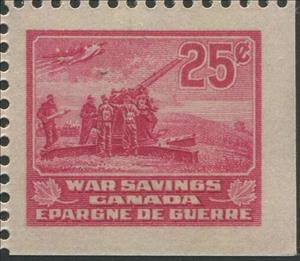Stamp: Anti-aircraft gun (Canada 1940)
Anti-aircraft gun (Canada 1940)
01 January (Canada ) within release War Savings goes into circulation Stamp Anti-aircraft gun face value 25 Canadian cent
| Stamp Anti-aircraft gun in catalogues | |
|---|---|
| Colnect codes: | Col: CA WS1940-10 |
Stamp is square format.
Van Dam Revenue Catalog #FWS14Also in the issue War Savings:
- Stamp - Anti-aircraft gun face value 25;
- Stamp - Bomber face value 25;
- Stamp - Destroyer face value 25;
- Stamp - Numeral face value 25;
- Stamp - Nurses face value 25;
- Stamp - Pilots face value 25;
- Stamp - Sailor face value 25;
- Stamp - Soldier face value 25;
- Stamp - Spitfire face value 25;
- Stamp - Tank face value 25;
- Booklet Pane - War Savings - booklet pane face value 8*25;
- Booklet - Canada War Savings Stamps face value 10;
- Booklet - Canada War Savings Stamps face value 10;
- Booklet - Canada War Savings Stamps face value 10;
- Stamp - Numeral face value 25;
- Booklet Pane - Numeral face value 8*25;
- Booklet Pane - Spitfire face value 8*25;
|
Data entry completed
50%
|
|
|---|---|
| Stamp Anti-aircraft gun in digits | |
| Country: | Canada |
| Date: | 1940-01-01 |
| Emission: | Savings Stamps |
| Format: | Stamp |
| Face Value: | 25 Canadian cent |
Stamp Anti-aircraft gun it reflects the thematic directions:
An aircraft (pl. aircraft) is a vehicle that is able to fly by gaining support from the air. It counters the force of gravity by using either static lift or the dynamic lift of an airfoil, or, in a few cases, direct downward thrust from its engines. Common examples of aircraft include airplanes, rotorcraft (including helicopters), airships (including blimps), gliders, paramotors, and hot air balloons.Part 1 (Definitions and Abbreviations) of Subchapter A of Chapter I of Title 14 of the U. S. Code of Federal Regulations states that aircraft "means a device that is used or intended to be used for flight in the air."
An army, ground force or land force is an armed force that fights primarily on land. In the broadest sense, it is the land-based military branch, service branch or armed service of a nation or country. It may also include aviation assets by possessing an army aviation component. Within a national military force, the word army may also mean a field army.
Aviation is the practical aspect or art of aeronautics, being the design, development, production, operation and use of aircraft, especially heavier than air aircraft. The word aviation was coined by French writer and former naval officer Gabriel La Landelle in 1863, from the verb avier (synonymous flying), itself derived from the Latin word avis ("bird") and the suffix -ation.



